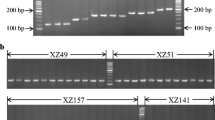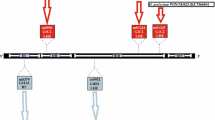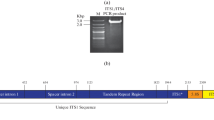Abstract
Group-I introns are widespread—though irregularly distributed—in eukaryotic organisms, and they have been extensively used for discrimination and phylogenetic analyses. Within the Verticillium genus, which comprises important phytopathogenic fungi, a group-I intron was previously identified in the SSU-rRNA (18S) gene of only V. longisporum. In this work, we aimed at elucidating the SSU-located intron distribution in V. dahliae and other Verticillium species, and the assessment of heterogeneity regarding intron content among rDNA repeats of fungal strains. Using conserved PCR primers for the amplification of the SSU gene, a structurally similar novel intron (sub-group IC1) was detected in only a few V. dahliae isolates. However, when intron-specific primers were used for the screening of a diverse collection of Verticillium isolates that originally failed to produce intron-containing SSU amplicons, most were found to contain one or both intron types, at variable rDNA repeat numbers. This marked heterogeneity was confirmed with qRT-PCR by testing rDNA copy numbers (varying from 39 to 70 copies per haploid genome) and intron copy ratios in selected isolates. Our results demonstrate that (a) IC1 group-I introns are not specific to V. longisporum within the Verticillium genus, (b) V. dahliae isolates of vegetative compatibility groups (VCGs) 4A and 6, which bear the novel intron at most of their rDNA repeats, are closely related, and (c) there is considerable intra-genomic heterogeneity for the presence or absence of introns among the ribosomal repeats. These findings underline that distributions of introns in the highly heterogeneous repetitive rDNA complex should always be verified with sensitive methods to avoid misleading conclusions for the phylogeny of fungi and other organisms.



Similar content being viewed by others
References
Altschul SF, Madden TL, Schäffer AA, Zhang J, Zhang Z, Miller W, Lipman DJ (1997) Gapped BLAST and PSI-BLAST: a new generation of protein database search programs. Nucleic Acids Res 25:3389–3402
Banno S, Saito H, Sakai H, Urushibara T, Ikeda K, Kabe T, Kemmochi I, Fujimura M (2011) Quantitative nested real-time PCR detection of Verticillium longisporum and V. dahliae in the soil of cabbage fields. J Gen Plant Pathol 77:282–291
Bhat RG, Smith RF, Koike ST, Wu BM, Subbarao KV (2003) Characterization of Verticillium dahliae isolates and wilt epidemics of pepper. Plant Dis 87:789–797
Bhattacharya D, Friedl T, Damberger S (1996) Nuclear-encoded rDNA group I introns: origin and phylogenetic relationships of insertion site lineages in the green algae. Mol Biol Evol 13:978–989
Bhattacharya D, Reeb V, Simon DM, Lutzoni F (2005) Phylogenetic analysis suggests reverse splicing spread of group I introns in fungal ribosomal DNA. BMC Evol Biol 5:68
Bilodeau GJ, Koike ST, Uribe P, Martin FN (2012) Development of an assay for rapid detection and quantification of Verticillium dahliae in soil. Phytopathology 102:331–343
Cannone JJ, Subramanian S, Schnare MN et al (2002) The comparative RNA web (CRW) site: an online database of comparative sequence and structure information for ribosomal, intron, and other RNAs. BMC Bioinforma 3:2 (Correction: BMC Bioinformatics 3:15)
Cech TR, Damberger SH, Gutell ER (1994) Representation of the secondary and tertiary structure of group I introns. Nat Struct Biol 1:273–280
Collins A, Okoli CAN, Morton A, Parry D, Edwards SG, Barbara DJ (2003) Isolates of Verticillium dahliae pathogenic to crucifers are of at least three distinct molecular types. Phytopathology 93:364–376
Correll JC, Klittich CJR, Leslie JF (1987) Nitrate nonutilizing mutants of Fusarium oxysporum and their use in vegetative compatibility tests. Phytopathology 77:1640–1646
D’haene B, Vandesompele J, Hellemans J (2010) Accurate and objective copy number profiling using real-time quantitative PCR. Methods 50:262–270
DePriest PT (1993) Small subunit rDNA variation in a population of lichen fungi due to optional group-I introns. Gene 134:67–74
Dobinson KF, Harrington MA, Omer M, Rowe RC (2000) Molecular characterization of vegetative compatibility groups 4A and 4B isolates of Verticillium dahliae associated with potato early dying. Plant Dis 84:1241–1245
Dujon B (1989) Group I introns as mobile genetic elements: facts and mechanistic speculations, a review. Gene 82:91–114
Garber RC, Turgeon BG, Selker EU, Yoder OC (1988) Organization of ribosomal RNA genes in the fungus Cochliobolus heterostrophus. Curr Genet 14:573–582
Hafez M, Iranpour M, Mullineux ST, Sethuraman J, Wosnitza KM, Lehn P, Kroeker J, Loewen PC, Reid J, Hausner G (2012) Identification of group I introns within the SSU rDNA gene in species of Ceratocystiopsis and related taxa. Fungal Biol 116:98–111
Haugen P, Simon DM, Bhattacharya D (2005) The natural history of group I introns. Trends Genet 21:111–119
Herrera ML, Vallor AC, Gelfond JA, Patterson TF, Wickes BL (2009) Strain-dependent variation in 18S ribosomal DNA copy numbers in Aspergillus fumigatus. J Clin Microbiol 47:1325–1332
Hibbett DS (1996) Phylogenetic evidence for horizontal transmission of group I introns in the nuclear ribosomal DNA of mushroom-forming fungi. Mol Biol Evol 13:903–909
Howlett BJ, Rolls BD, Cozijnsen AJ (1997) Organisation of ribosomal DNA in the ascomycete Leptosphaeria maculans. Microbiol Res 152:261–267
Ikeda K, Banno S, Watanabe K et al (2012) Association of Verticillium dahliae and Verticillium longisporum with Chinese cabbage yellows and their distribution in the main production areas of Japan. J Gen Plant Pathol 78:331–337
Inderbitzin P, Davis RM, Bostock RM, Subbarao KV (2011) The ascomycete Verticillium longisporum is a hybrid and a plant pathogen with an expanded host range. PLoS One 6:e18260. doi:10.1371/journal.pone.0018260
Inderbitzin P, Davis RM, Bostock RM, Subbarao KV (2013) Identification and differentiation of Verticillium species and V. longisporum lineages by simplex and multiplex PCR assays. PLoS One 8:e65990. doi:10.1371/journal.pone.0065990
Joaquim TR, Rowe RC (1990) Reassessment of vegetative compatibility relationships among strains of Verticillium dahliae using nitrate-nonutilizing mutants. Phytopathology 80:1160–1166
Johansen JS, Haugen P (2001) A new nomenclature of group I introns in ribosomal DNA. RNA 7:935–936
Johansson A, Goud JKC, Dixelius C (2006) Plant host range of Verticillium longisporum and microsclerotia density in Swedish soils. Eur J Plant Pathol 114:139–149
Karapapa VK, Typas MA (2001) Molecular characterization of the host-adapted pathogen Verticillium longisporum on the basis of a group-I intron found in the nuclear SSU-rRNA gene. Curr Microbiol 42:217–224
Karapapa VK, Bainbridge BW, Heale JB (1997) Morphological and molecular characterization of Verticillium longisporum comb. nov., pathogenic to oilseed rape. Mycol Res 101:1281–1294
Katan T (2000) Vegetative compatibility in populations of Verticillium—an overview. In: Tjamos EC, Rowe RC, Heale JB, Fravel DR (eds) Advances in Verticillium: research and disease management. American Phytopathological Society Press, St. Paul, pp 69–86
Klosterman SJ, Atallah ZK, Vallad GE, Subbarao KV (2009) Diversity, pathogenicity, and management of Verticillium species. Annu Rev Phytopathol 47:39–62
Lee C, Lee S, Shin SG, Hwang S (2008) Real-time PCR determination of rRNA gene copy number: absolute and relative quantification assays with Escherichia coli. Appl Microbiol Biotechnol 78:371–376
Leslie JF (1993) Fungal vegetative compatibility. Annu Rev Phytopathol 31:127–150
Li Z, Zhang Y (2005) Predicting the secondary structures and tertiary interactions of 211 group I introns in IE subgroup. Nucleic Acids Res 33:2118–2128
Lickey EB, Hughes KW, Petersen RH (2003) Variability and phylogenetic incongruence of an SSU nrDNA group I intron in Artomyces, Auriscalpium, and Lentinellus (Auriscalpiaceae: Homobasidiomycetes). Mol Biol Evol 20:1909–1916
Maleszka R, Clark-Walker GD (1993) Yeasts have a four-fold variation in ribosomal DNA copy number. Yeast 9:53–58
Michel F, Westhof E (1990) Modelling of the three-dimensional architecture of group I catalytic introns based on comparative sequence analysis. J Mol Biol 216:585–610
Müller KM, Cannone JJ, Gutell RR, Sheath RG (2001) A structural and phylogenetic analysis of the group IC1 introns in the order Bangiales (Rhodophyta). Mol Biol Evol 18:1654–1667
Nielsen H, Johansen SD (2009) Group I introns: moving in new directions. RNA Biol 6:375–383
Nikoh N, Fukatsu T (2001) Evolutionary dynamics of multiple group I introns in nuclear ribosomal RNA genes of endoparasitic fungi of the genus Cordyceps. Mol Biol Evol 18:1631–1642
Pantou MP, Typas MA (2005) Electrophoretic karyotype and gene mapping of the vascular wilt fungus Verticillium dahliae. FEMS Microbiol Lett 245:213–220
Pantou MP, Mavridou A, Typas MA (2003) IGS sequence variation, group-I introns and the complete nuclear ribosomal DNA of the entomopathogenic fungus Metarhizium: excellent tools for isolate detection and phylogenetic analysis. Fungal Genet Biol 38:159–174
Papaioannou IA, Dimopoulou CD, Typas MA (2013a) Structural and phylogenetic analysis of the rDNA intergenic spacer region of Verticillium dahliae. FEMS Microbiol Lett 347:23–32
Papaioannou IA, Ligoxigakis EK, Vakalounakis DJ, Markakis EA, Typas MA (2013b) Phytopathogenic, morphological, genetic and molecular characterization of a Verticillium dahliae population from Crete, Greece. Eur J Plant Pathol 136:577–596
Pegg GF, Brady BL (2002) Verticillium wilts. CABI Publishing, New York
Rooney AP, Ward TJ (2005) Evolution of a large ribosomal RNA multigene family in filamentous fungi: birth and death of a concerted evolution paradigm. Proc Natl Acad Sci USA 102:5084–5089
Sambrook J, Russell DW (2001) Molecular cloning: a laboratory manual, 3rd edn. Cold Spring Harbor Laboratory Press, New York
Simon DM, Hummel CL, Sheeley SL, Bhattacharya D (2005) Heterogeneity of intron presence or absence in rDNA genes of the lichen species Physcia aipolia and P. stellaris. Curr Genet 47:389–399
Tran VT, Braus-Stromeyer SA, Timpner C, Braus GH (2013) Molecular diagnosis to discriminate pathogen and apathogen species of the hybrid Verticillium longisporum on the oilseed crop Brassica napus. Appl Microbiol Biotechnol 97:4467–4483
Typas MA, Griffen AM, Bainbridge BW, Heale JB (1992) Restriction fragment length polymorphisms in mitochondrial DNA and ribosomal RNA gene complexes as an aid to the characterization of species and sub-species populations in the genus Verticillium. FEMS Microbiol Lett 95:157–162
Untergasser A, Nijveen H, Rao X, Bisseling T, Geurts R, Leunissen JAM (2007) Primer3Plus, an enhanced web interface to Primer3. Nucleic Acids Res 35(suppl. 2):W71–W74
Vicens Q, Paukstelis PJ, Westhof E, Lambowitz AM, Cech TR (2008) Toward predicting self-splicing and protein-facilitated splicing of group I introns. RNA 14:2013–2029
Wang C, Li Z, Typas MA, Butt TM (2003) Nuclear large subunit rDNA group I intron distribution in a population of Beauveria bassiana strains: phylogenetic implications. Mycol Res 107:1189–1200
Woodson SA (2005) Structure and assembly of group I introns. Curr Opin Struc Biol 15:324–330
Zuker M (2003) Mfold web server for nucleic acid folding and hybridization prediction. Nucleic Acids Res 31:3406–3415
Acknowledgments
We are grateful to all individuals mentioned in the footnote of Table 1 for providing fungal isolates used in this study. Ioannis A. Papaioannou and this research have been co-financed by the European Union (European Social Fund—ESF) and Greek national funds through the Operational Program “Education and Lifelong Learning” of the National Strategic Reference Framework (NSRF)—Research Funding Program: Heracleitus II. Investing in knowledge society through the European Social Fund.
Author information
Authors and Affiliations
Corresponding author
Additional information
Communicated by S. Hohmann.
Electronic supplementary material
Below is the link to the electronic supplementary material.
Rights and permissions
About this article
Cite this article
Papaioannou, I.A., Dimopoulou, C.D. & Typas, M.A. “Cryptic” group-I introns in the nuclear SSU-rRNA gene of Verticillium dahliae . Curr Genet 60, 135–148 (2014). https://doi.org/10.1007/s00294-013-0417-7
Received:
Revised:
Accepted:
Published:
Issue Date:
DOI: https://doi.org/10.1007/s00294-013-0417-7




